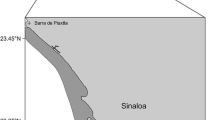Abstract
Direct observations of predation on 436 individuals of the sea urchin Paracentrotus lividus (Lamarck) were carried out in infralittoral rocky bottoms (between 5 and 20 m deep) in three Mediterranean marine reserves. The predator guild was composed of six fish species, the sparids Diplodus sargus and D. vulgaris being the main predators, and the labrid Coris julis a major predator of juvenile sea urchins. Four species attempted but failed to open sea urchins. The scavenger guild was most rich in species, with 17 species observed. Predation was size-dependent; the size of predators increased with increasing size of the sea urchins. The presence of two feeding guilds is suggested, one composed of sparids (Diplodus spp.), able to kill juvenile and adult sea urchins, and the other composed of labrids (mainly C. julis), which feed on juvenile sea urchins. To avoid the extension of overgrazed, barren areas created by P. lividus populations, fisheries' regulations should focus on major sea-urchin predators, chiefly D. sargus, D. vulgaris and C. julis.
Similar content being viewed by others

Author information
Authors and Affiliations
Additional information
Received: 23 April 1997 / Accepted: 30 May 1997
Rights and permissions
About this article
Cite this article
Sala, E. Fish predators and scavengers of the sea urchin Paracentrotus lividus in protected areas of the north-west Mediterranean Sea. Marine Biology 129, 531–539 (1997). https://doi.org/10.1007/s002270050194
Issue Date:
DOI: https://doi.org/10.1007/s002270050194



